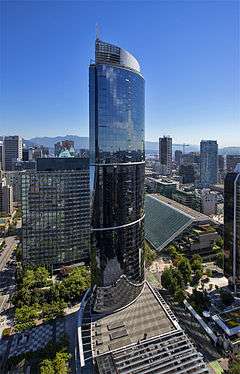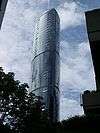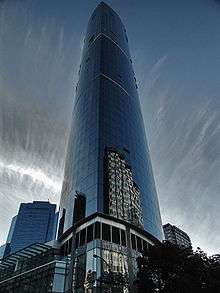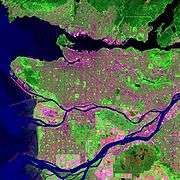One Wall Centre
| One Wall Centre | |
|---|---|
 | |
| General information | |
| Status | Complete |
| Type |
Residential condominiums Hotel |
| Architectural style | Modernism |
| Location |
1088 Burrard Street Vancouver, British Columbia, Canada |
| Coordinates | 49°16′50″N 123°07′37″W / 49.28046°N 123.1270°WCoordinates: 49°16′50″N 123°07′37″W / 49.28046°N 123.1270°W |
| Construction started | 1998 |
| Completed | 2001 |
| Height | |
| Antenna spire | 157.8 m (518 ft) |
| Roof | 149.8 m (491 ft) |
| Technical details | |
| Floor count | 48 |
| Floor area | 42,955 m2 (462,360 sq ft) |
| Lifts/elevators | 8 |
| Design and construction | |
| Architect | Perkins and Will |
| Developer | Wall Financial Corporation |
| Structural engineer | Glotman•Simpson Consulting Engineers |
| Main contractor | Siemens Development |
| Other information | |
| Number of units |
Rooms = 344 Suites = 70 Condo = 74 |
| References | |
| [1][2][3][4] | |
One Wall Centre, also known as the Sheraton Vancouver Wall Centre North Tower, is a 48-storey, 157.8 m (518 ft) skyscraper hotel with residential condominiums in the Wall Centre development at 1088 Burrard Street in Downtown Vancouver, British Columbia, Canada. The tower was designed by Perkins+Will Canada, and completed in 2001, and went on to win the Emporis Skyscraper Award for the Best New Skyscraper the same year. As of November 2012 it is the third-tallest completed building in the city.
Background
The first 27 floors of the building are the 4 Diamond Sheraton Hotel. Floors 28, 29, and 30 are the Club Intrawest Resort floors; which are operated independent of Sheraton. Floors 31 to 48 are residential condominiums. The One Wall Centre tower is part of the Wall Centre complex owned by Wall Financial Corporation and was largely the vision of Peter Wall.
Construction
To counteract possible harmonic swaying during high winds, One Wall has a tuned water damping system at the top level of the building which consists of two specially designed 50,000-imperial-gallon (60,000 U.S. gal; 227,300 L)[5] water tanks. These tanks are designed so that the harmonic frequency of the sloshing of the water in the tanks counteracts the harmonic frequency of the swaying of the building.
The tower exterior has a two-tone appearance. The glass on the lower levels is a dark glass, while the glass on the upper levels is light coloured glass. To satisfy the City of Vancouver Planning Department, who were concerned that the tower would dominate the downtown skyline, it was agreed that it would have a very "light" appearance that would blend in with a blue sky. After the design was approved, a minor amendment was requested to change it to a significantly darker glass. This was approved by a low level staff member in the planning department who apparently did not realize the significance of this change. When the glass started to be put on the building the city planners noted that this did not meet design that was reviewed by the public and the city planning department. After many accusations back and forth as to the significance of this change and whether it required public review, the City agreed to compromise and allowed the lower glazing that was already installed to be the dark glazing, but required that the glazing on the upper levels be the light glazing that was originally proposed.
The end result is the two toned structure that many consider would have been more architecturally stimulating if the single dark glazing had been allowed. Rumour has it that hotel owner Peter Wall threatened to call off the construction if the city forced him to replace all of the dark-paned glass, so a settlement was reached where only the remaining portion of the building (one third of its height) was faced with the typical "Yaletown green" light-coloured glass now common in the city's newer areas. The attempt to maintain the dark blue appearance did not end there; the windows in the upper third were installed with dark blue blinds facing outwards. If all blinds were to be drawn at once, the building would achieve the intended dark blue appearance.
However, a fogging effect put the long-term safety of these windows into question and the non-reflective nature of the light glass led to very high air-conditioning costs for residents. In 2010 the strata council for the owners of the residential portion of the One Wall building approved a major project to replace all of the windows in all of the residential units. The cost of replacement was estimated at $6.5 million. In 2012 the strata council received approval from the City to replace the light-coloured windows with matching dark windows. Subsequently, the strata council and the developer agreed to share the cost of window replacement and beginning in July 2013 the developer began replacing the light-coloured glass with dark glass that matched the remainder of the tower.
The Sheraton Wall Centre required a 23 m (75 ft) deep excavation — the deepest excavation prior to Living Shangri-La for a building in the city.[5]
According to the June 2004 edition of Elevator World, Richmond Elevator Maintenance Ltd. won a contract for the lowest bid to supply the building's elevators, one of the local elevator firm's first examples of traction elevators. The installation features 10 elevators, 8 of which are high speed geared machines. The hotel is served by four 1,400 kg (3,100 lb) traction elevators at 244 m/min (800 ft/min), with a group of 3 for public usage and a single private VIP access elevator. There are also two hotel service elevators with 1,800 kg (4,000 lb) capacity each at 213 m/min (700 ft/min). The apartments are served by 2 elevators, each with a capacity of 1,600 kg (3,500 lb) at 305 m/min (1,000 ft/min). There are also 2 roped hydraulic elevators: the 1,400 kg (3,100 lb) to serve the parking garage, and the 2,300 kg (5,100 lb) to serve the banquet floors. There are 6 escalators installed by Fujitec.
Cultural references
- This building was featured in the movie X-Men: The Last Stand as one of the buildings they used to give the cure to the mutants.
- The opening sequence of The Core, where a man collapses at a business meeting and the camera pans out to the street to show a number of simultaneous accidents, was filmed here.
- The plaza directly in front of this building was used in exterior shots for the 1996 Fox TV Series Profit to represent the immediate area outside the corporate offices of fictional Gracen & Gracen Inc (G&G). While the One Wall Centre building did not exist in 1996 when the series was filmed, the two towers immediately adjacent to this building were featured prominently in the series as the corporate headquarters for G&G.
- The courtyard of the Wall Centre appears in Caprica's season 1 episode, Retribution.
Gallery
See also
References
- ↑ "One Wall Centre". CTBUH Skyscraper Database.
- ↑ One Wall Centre at Emporis
- ↑ "One Wall Centre". SkyscraperPage.
- ↑ One Wall Centre at Structurae
- 1 2 "One Wall Centre Project". Glotman•Simpson. Retrieved 2007-02-06.
External links
| Wikimedia Commons has media related to One Wall Centre. |
- One Wall Centre condominiums official website
- One Wall Centre project page at the Glotman•Simpson Group
- Emporis 2001 Award



